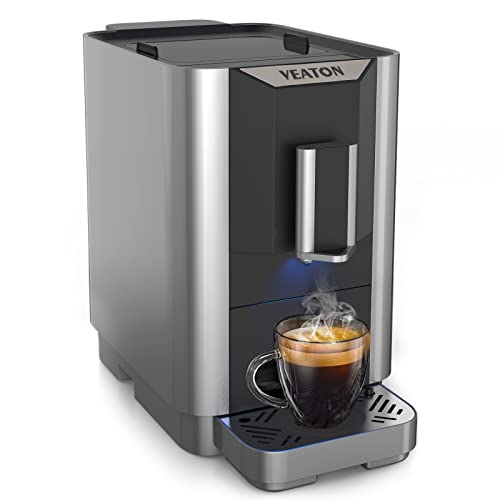Espresso Maker - A Must-Have For Home Baristas
Espresso is a strong dark-brown, dark-colored drink created by pushing hot water through finely packed, tightly ground coffee. It is the base of many popular coffee drinks.
A skilled barista (also known as an espresso maker) is in control of a variety of variables to make an excellent cup of espresso. This includes the temperature of water it's pressure, as well as how tightly packed the coffee is.
Origins
The espresso maker is a machine which pushes small amounts near boiling water under high pressure through coffee beans that have been finely ground. The resultant drink is stronger than drip coffee, is more concentrated, and served in smaller cups. This is an excellent choice for those who need a strong cup of espresso but need it fast!
In the 19th century, the first espresso machines were invented. The coffee industry was huge in the 19th century, however, brewing required too much time. People everywhere were desperate for a quick cup!
In 1884, Angelo Moriondo from Turin patented the first coffee machine. It was branded with a title that was "New steam machinery for the economical and instantaneous confection of coffee beverages Method A. Moriondo."
Luigi Bezzerra, Desiderio Pavoni and other Milanese manufacturers improved and modified the machine. They introduced the portafilter, several brewheads, as other innovations still associated with espresso makers today. The Ideale was their machine that was popular with the crowd at the 1906 Milan Fair. Today Moka pots are used in Moka pot is located in nine out of ten Italian households.
Variations
Espresso's flavor is more concentrated than coffee, and it works well with milk and other ingredients to make popular coffee drinks like cappuccinos and lattes. The strong flavor of espresso is evident in baked goods recipes marinades, as well as other dishes.
There are four kinds of espresso machines: semi-automatic, super-automatic, manual lever and. Each one uses a different method of extracting espresso.
A manual lever machine makes use of a piston made of metal that presses water through the ground. It's a great alternative to human control and mechanized accuracy. You still have to grind, tamp, and pull the shot by hand but you'll have more control over water temperature and pressure.
Moka pots are a second manual espresso maker that operates similar to modern pump-driven espresso machine. In an airtight, sealed tank, boiling water produces steam. espresso coffee machine is then transported into a basket containing ground coffee and through a filter made of metal into the top cup. These machines are more affordable, but they can only generate 1-1.5 bars of steam pressure. This isn't enough to make espresso.
Ingredients
Espresso makers can aid baristas at home make cafe-style drinks like lattes and cappuccinos. You can also add flavorful extracts or syrups to espresso shots for an indulgent drink like the espresso martini.
The key ingredients for a great cup of espresso are premium coffee beans freshly brewed milk and sugar. To ensure a consistent extraction, look for beans that have a specific espresso label. Finely grind them. You can experiment with different roasts until you find the one that matches your preferences.

There is also an espresso grinder, which grinds beans to a consistent texture. The espresso machine is equipped with a portafilter, which stores the grounds, as well as an tamper which is used to squeezing the coffee into a tightly packed.
In the end, you'll need a set of espresso cups and a steamer or frother to create the silky aerated milk typical of espresso drinks. Some machines come with a steam wand built in, which can make this process easier and quicker. It is also essential to clean the machine, which involves running a solution of water and vinegar through the system.
Techniques
Espresso brewing is based on creating pressure to quickly extract the intense flavor from finely ground, dark-roasted coffee packed tightly into a 'puck. This method of brewing produces an intense coffee shot, known as espresso. If done correctly, espresso features a luxurious crema (or dense foam) over the top.
The majority of espresso makers utilize high-pressure water to force through finely ground coffee with high temperatures. This differs from the Moka Express, which uses heat to remove coarsely ground coffee. This results in an espresso-like beverage that is diluted in milk or water to make other drinks such as cappuccinos or lattes.
The Moka Express is a low-cost, simple appliance. Other espresso machines, however, are more complicated, costly and offer a variety of drinks. The most well-known models, however, are Italian-designed lever machines which use spring-loaded arms that release hot water from a cylinder into a portafilter. The barista can adjust variables like water temperature and grind size shot-by-shot to achieve the best results. These machines were instrumental in bringing espresso to greater recognition throughout Italy and Europe.
Equipment
A high-quality espresso machine should be able to extract soluble and non-soluble solids from finely grinded tightly packed coffee. This is made possible through the use of pressure and controlled variables, such as temperature and grind size. Then there's the taste, which is dependent on several factors including the beans as well as the way they're handled and brewed.
There are various types of machines that produce espresso, but the most common is the semiautomatic machine. It uses an electric pump to move the water around and push it through the grounds. The user can also do the grinding and tamping. These machines are the most affordable, however they're not as reliable as spring pistons or other designs that are manual.
The lever models which are more expensive include an oblique cylinder that is calibrated to do all the work. These are a bit more flexible than a spring piston machine but require some knowledge to use properly. These machines require more maintenance. It is necessary to heat up the portafilter, and remove the portafilter and piston every time.
